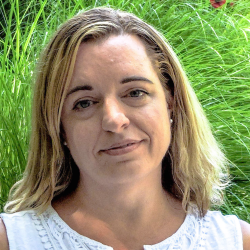
Here's a question many educators, schools, and districts have been asking lately...
How can we structure and sequence remote, online, or hybrid learning, in order to balance synchronous and asynchronous activities?
The more I think about it, the more convinced I am that Project Based Learning offers us a clear and compelling answer to this pressing question.
Let’s start with the instructional sequence...
If you’ve participated in our PBL 101 Workshop – or another highly engaging learning experience – you may recognize this pattern...
- Step 1: Establish a purpose for learning. Connect with your current goals, questions, or challenges.
- Step 2: Engage with new information through a short lecture, video, article, or other learning experience. Process and reflect on that information – individually at first, then in a pair or small group, then with the larger group.
- Step 3: Apply the information in authentic work (in the case of the PBL 101, this is the project you are developing throughout the workshop). Reflect on your work and give and receive collegial feedback on others’ works-in-progress.
- Repeat steps 2 and 3 several times to explore a variety of topics or questions related to the learning goals established in Step 1.
- Step 4: Synthesize and summarize your takeaways from the learning experience. Reflect on and celebrate what you’ve learned.
If you’re familiar with the PBLWorks Project Path, you’ll notice that the steps above map to the four phases of a PBL project...
- Project Phase 1: The launch (entry event and driving question)
- Project Phase 2: Building knowledge and skills
- Project Phase 3: Developing products and answers to the driving question
- Project Phase 4: Presenting products and answers to the driving question
So how does this help us answer the question about structuring remote online or hybrid learning?
One way to approach this challenge is to a.) design a series of learning experiences following the PBL Project Path, b.) determine whether each experience will be synchronous or asynchronous, then c.) map on the appropriate structures and digital tools to support that sequence of learning and facilitate collaboration.
PBL Phase | Learning Activity | Synchronous or Asynchronous? | Possible Tech Tools |
PHASE 1 | Establish a purpose for learning | synchronous | Video conference: Google Meet, GoToMeeting, Zoom Interactive presentation: Mentimeter, Nearpod, Pear Deck |
PHASE 1 | Connect with students goals, questions, or challenges | asynchronous or synchronous | Audio/Video discussion: FlipGrid, GoSynth, Padlet Collaborative board/Concept map: Jamboard, Miro, Mural, Padlet, Popplet Discussion board in your LMS: Canvas, Google Classroom, Schoology, etc. Poll/survey: Google Forms, Poll Everywhere, Survey Monkey Shared document |
PHASE 2 | Independently engage with and process new information | asynchronous, including no/low tech when possible (e.g., reading offline, interviewing a family member, drawing, writing) | Interactive articles: Actively Learn, InsertLearning, Newsela Interactive videos: EdPuzzle, PlayPostIt, TED-Ed Multimedia playlist: eLink, Symbaloo, Wakelet Podcasts: Listenwise, Stitcher Teacher-created animated video: Doodly, Explain Everything, SimpleShow Video Maker Teacher-created screencast: Loom, Screencastify, Screencast-o-matic |
PHASE 2 | Collaboratively process and reflect on new information | asynchronous | Audio/Video discussion: FlipGrid, GoSynth, Padlet Collaborative board/Concept map: Miro, Mural, Padlet, Popplet, Webjets Collaborative multimedia annotation: Glogster, ThingLink, VoiceThread Collaborative text annotation: Diigo, Hypothes.is, Kami Discussion board in your LMS: Canvas, Google Classroom, etc. |
PHASE 3 | Apply that information in authentic work | synchronous, then asynchronous - again, including no/low tech when possible | Project management: Trello, Twist Book creation/Writing publication: BookCreator, Storybird, Write About, WriteReader Infographic creation: Canva, Creately, Easelly, Infogram, Piktochart, Venngage Podcast creation: Anchor, Soundtrap Video creation: Adobe Spark, Animoto, Stop Motion Studio, WeVideo Website creation: Google Sites, Weebly, Wix |
PHASE 3 | Reflect on your work and give/receive collegial feedback | asynchronous or synchronous | Video conference breakout rooms Text, audio, or video feedback tools such as Google Docs comments, FlipGrid, Kaizena, Loom, PeerGrade, Seesaw |
PHASE 4 | Synthesize, summarize, reflect on, and celebrate your learning | asynchronous, then synchronous | Final product and reflection tools from the two rows above Video conference |
Fundamentally, we need to be selective about synchronous learning: when and why do we bring the whole class together?
The move to online teaching and learning gives us the opportunity to move beyond the constraints of a traditional school schedule. And when students are learning from home, it’s especially important to make the experience flexible and offer no- or low-tech options when possible.
That said, the entry event or launch of a new unit of study is an important time for the whole class to come together synchronously. Students can engage in a powerful shared experience - such as a guest speaker, virtual field trip, or thought-provoking discussion - and then collaboratively generate their need-to-know questions on a shared document or discussion board.
At the end of the project, too, it’s important for students to have a collective experience sharing their work with an authentic audience and reflecting on what they’ve learned throughout the project.
But what about the middle of the project (Steps 2 & 3) where students are engaging in new learning and applying that learning in their project work? This is where I think we can best take advantage of the opportunity to rethink our learning experience design.
Here’s one example of how it might play out...
The teacher creates a short video to introduce the first phase of inquiry. Using one of the students’ need to know questions as a jumping off point, the teacher introduces a playlist of resources for students to explore in answer to that question. Students watch the teacher video and engage with the information in the resources, as well as with their peers, asynchronously. They collaboratively annotate the materials, take notes in a shared document, use audio/video tools to respond to reflection questions, and participate in an online discussion forum.
Then, students come together synchronously in a combination of whole class video conference and small group breakout sessions to share key takeaways from their learning, discuss any outstanding questions or misconceptions, and apply their new learning to their project work. Once students have begun the project work together, the teacher provides tools and structures for students to continue that project work asynchronously. After students have reached a designated checkpoint, the teacher formatively assesses their progress and determines when they are ready to move forward.
This general pattern of asynchronous-to-synchronous-to-asynchronous can be used to structure each phase of inquiry or milestone in the project.
The rhythm and flow of this structure allows us to be intentional and deliberate about when and why we are bringing students together for synchronous whole group learning while maximizing the use of the online environment - with its learning management systems, collaboration tools, etc. – to keep students engaged in the work asynchronously while providing individualized support to students and project teams.
One of the greatest opportunities in the move to online learning is the freedom to rethink how we organize ourselves, our time, and our resources in order to create a more personalized and supportive learning environment for all students. With the kind of schedule I’ve described here, teachers will have much greater capacity to provide meaningful coaching and feedback to students, both asynchronously (using text, audio, and video tools), as well as synchronously through one-on-one check-ins and coaching sessions.
I heard a compelling debate at the 2010 International Society for Technology in Education Annual Conference in which the speakers were arguing the relative merits of online vs. brick and mortar schools. The conclusion I drew was that each form of schooling has its advantages and its drawbacks, and we should use each to its full advantage. The same is true for synchronous and asynchronous environments in online learning.
What do you think? We'd love to hear from you on Facebook or Twitter @PBLWorks!

